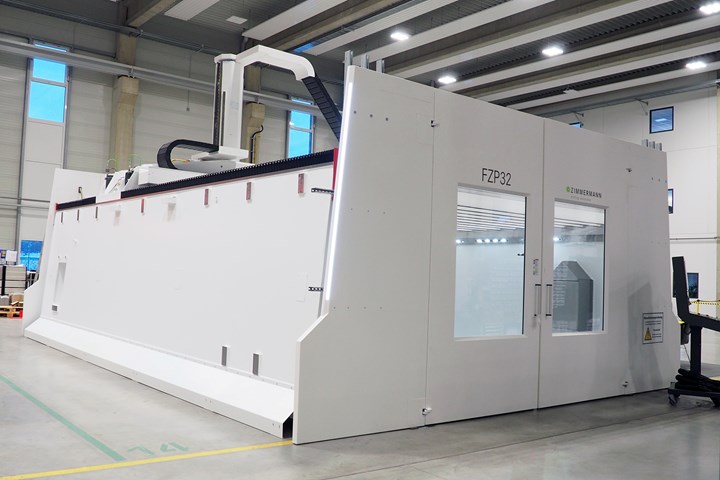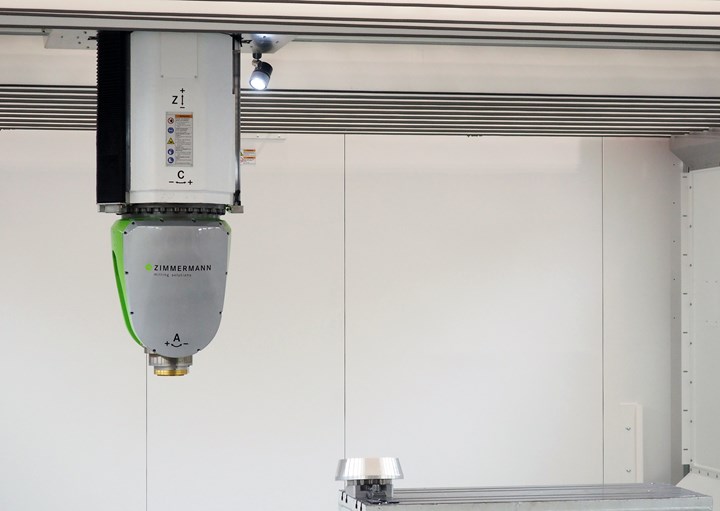Stability, High Speed, Flexibility of Five-Axis Portal Milling Machine Reduces Rework for Mold Builder
The thermo-symmetrical construction of a five-axis portal milling machine with a center-guided Z-axis enables higher accuracy, reducing rework. Also, the symmetrical design and the guide arrangement increase stability and save weight, making the machine more dynamic, productive and energy-efficient.
Share

The five-axis portal milling machine FZP32 is very accurate thanks to its thermo-symmetrical design. It offers high productivity and untended operation for the shop. All photo credit: Zimmermann Inc.
"What makes us so successful?" Maximilian Lörzel, managing director of Schröter Modell- und Formenbau GmbH in Oberpframmern near Munich in Bavaria does not need to think twice. "We have highly qualified employees who can program and operate the machines. We train ourselves and offer complete production from a single source. "
For design and five-axis NC programming, the company relies on the Catia and Tebis software solutions, in combination with the milling machines from Zimmermann. Schröter's team grew up with these machines, he notes. Lörzel appreciates the stability, high speed and flexibility of these systems. They work precisely and reliably. "The parts produced barely or never need to be reworked after removal from the machine, depending on the work time. This alone saves us considerable time and money," emphasizes the managing director.
In 1991, Schröter Modell- und Formenbau invested in the first milling center from the Zimmermann family of machines. Today, five Zimmermann systems of different sizes are located in Oberpframmern – about as many fit into the shop, Lörzel muses. "Because we rely on machines from the same manufacturer, we can pursue a common parts strategy," says Lörzel. "This means that if a system fails, an employee can simply switch the component to another machine of suitable size during individual part production. For this reason, all the Zimmermann mills are equipped with the same Heidenhain CNC controller, comparable milling heads and simulation software from Tebis.
Machinery Continuously Renewed
In their 30 years, Schröter has replaced four machines with newer versions. "Now it's the fifth and thus the ninth Zimmermann machine," says Lörzel looking at Frieder Gänzle. The managing director of F. Zimmermann GmbH met with Lörzel recently for the acceptance of the new FZP32. "The old FZ37 series, which we are now taking out of production in Oberpframmemern, is 18 years old," says Lörzel. "It is still running reliably, but due to age, small signs of wear occur repeatedly; sometimes it was a defective power supply, sometimes the graphics card. "
With the new FZP32, the same workspace is available. Parts like vehicle models can be completely machined from five sides without reclamping. The machine's modular design offers the possibility to consider various options – for example, automation solutions such as shuttle tables, a positionable rotary table, dust extraction bells or an individualized tool clamping system. Most importantly, Schröter is taking a significant step forward because the new portal milling machine achieves maximum dimensional accuracy when machining the parts. "This is due to their thermo-symmetrical structure," says Zimmermann Managing Director Gänzle, explaining the company's industry-unique design concept.

Schröter will be able to process complete vehicle models from five sides in a single setup.
Thermosymmetry for More Precision
Changing environmental temperatures and process heat inevitably influence machine geometry in conventional portal mill designs. The idea of the thermosymmetric structure is based on the fact that thermal influences can be absorbed to a considerable extent by the design of the machine structure.
"For this purpose, we intelligently designed and arranged structural and drive components, guides and other accuracy-determining components for the machines in our newly developed portfolio. The structure can thus expand predictably in non-critical directions," Gänzle describes. The centrally guided Z-slide of the portal in double bridge construction has an octagonal cross-section, which makes it particularly stable. With this setup, the machine can achieve a very high rigidity. Without unilateral heating, this increases the accuracy enormously. The Zimmermann design reduces the effects of the error-influencing variables to a minimum.
Since there are fewer lever forces than in a serial structure with a classic guide arrangement, the machine builder can build the FZP rigidly. The octagonal Z-slide is more stable and yet slimmer in profile. Less mass needs to be moved, and the machine works faster and more dynamically, which means the operator is more productive. This also requires less energy. These are clear cost advantages. In addition, the thermosymmetric structure eliminates the need for complex cooling circuits, which positively affects operating costs.
Zimmermann machines work precisely and reliably. "The parts produced barely or never need to be reworked after removal from the machine, depending on the work time. This alone saves us considerable time and money," emphasizes the managing director.
Smart Milling
In the shop in Neuhausen, Frieder Gänzle points to the FZP milling head, "The Zimmermann VH10 is in use here. The fork head is designed in monoblock versions made of cast iron. It has a compact design, achieves high clamping forces and thus enables stable component machining."
Zimmermann optionally equips the VH10 with process cooling with cooling lubricants or minimum quantity lubrication. To reduce throughput times, a powerful spindle with 34 kilowatts at a maximum speed of 24,000 rpm is installed as standard. In addition, there is an optional dust extraction bell around the milling tool. The interfering contour of the entire Z-axis is also important for customers. In addition to high power density, the focus during development was on the slimline. The closer the operator can move the milling head to the part, the shorter tools can be used; thus, more material can be removed, notes Gänzle.
This new concept of the FZP convinced Maximilian Lörzel. "Especially when we run the machine for seven hours at a time, we need to make sure that it remains temperature-stable over this long period," he says. This is even more important on the weekends because running times of up to 40 hours at a time can often accumulate. First, the system mills one side of a vehicle, then the other. If long running times result in a slight temperature imbalance, a small step on the rear side of the model occurs. With the new thermostable machine, rework is almost eliminated. In addition, the effort involved in programming in advance is reduced, as less consideration must be given to the thermal behavior of the machine.
In Oberpframmern, the FZP is placed on the foundation of the old machine. Therefore, the size of the machine was already determined. The machine table base is also utilized. Control and media cabinets are placed on a pedestal due to the tight space conditions in the facility.

In addition to high power density, the focus during the development of the VH10 milling head was, above all, on its slim line.
Investment Pays Off
The federal government supported this investment in the new FZP by Schröter in times of crisis. With more modern technology, the aim was to make the German economy and especially medium-sized companies, competitive again. "Of course, that made the decision easier for us," recalls Lörzel. "And we knew it would be on our to-do list for three to five years." He expects that the FZP will pay for itself after about eight years. "Of course, nobody knows what the market will look like in three years, but since the summer of 2022, the order volume has been rising steadily again for us," says Lörzel. Schröter recently won two new customers from the aviation industry and medical technology markets based in the U.S. He is happy that German quality is still in demand worldwide.
This also works well for the new FZP32, where the model and moldmakers partly mill components for helicopters and airplanes – including for companies such as Airbus. Rolls Royce Triebwerkstechnik in Berlin has recently become one of Schröter's customers. Typical components are, for example, engine covers, which must be milled very precisely and, if possible, without offsets. Lörzel says, "With the current order situation, we expect 60 to 70 models for complete cars per year in the automotive industry. We also use the new FZP32 for this purpose, as well. " Schröter is planning a two-shift utilization of the new system, possibly even an untended shift – depending on the range of parts. This results in about 3,500 to 4,000 operating hours per year.
Related Content
Moldmakers Deserve a Total Production Solution
Stability, spindle speed and software are essential consideration for your moldmaking machine tool.
Read MorePrecision Meets Innovation at IMTS 2024
After attending IMTS, it's clear that the integration of advanced technologies is ready to enhance precision, efficiency and automation in mold manufacturing processes. It’s a massive event, so here’s a glimpse of what the MMT team experienced firsthand.
Read MoreMachining Center Spindles: What You Need to Know
Why and how to research spindle technology before purchasing a machining center.
Read MoreThe Benefits of Hand Scraping
Accuracy and flatness are two benefits of hand scraping that help improve machine loop stiffness, workpiece surface finish and component geometry.
Read MoreRead Next
How to Use Continuing Education to Remain Competitive in Moldmaking
Continued training helps moldmakers make tooling decisions and properly use the latest cutting tool to efficiently machine high-quality molds.
Read MoreHow to Use Strategic Planning Tools, Data to Manage the Human Side of Business
Q&A with Marion Wells, MMT EAB member and founder of Human Asset Management.
Read MoreAre You a Moldmaker Considering 3D Printing? Consider the 3D Printing Workshop at NPE2024
Presentations will cover 3D printing for mold tooling, material innovation, product development, bridge production and full-scale, high-volume additive manufacturing.
Read More





















